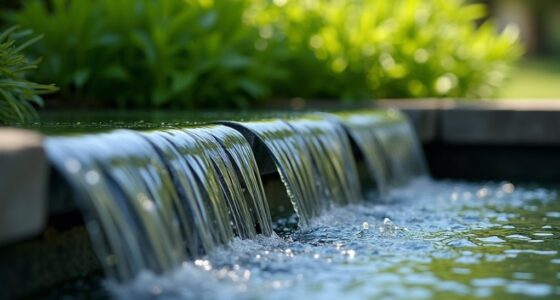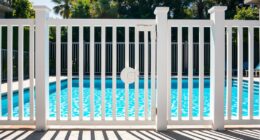To backwash without draining the basin, first turn off your pump and set the filter valve to “Backwash.” Connect your backwash hose securely, then restart the pump and monitor pressure and flow. Continue until water runs clear, then turn off the pump, switch the valve to “Rinse,” and rinse briefly before returning to “Filter.” Properly executing each step helps keep your pool water clean without draining the basin—learn more for expert tips.
Key Takeaways
- Regularly monitor filter pressure and water clarity to identify when backwashing is needed, avoiding unnecessary basin drainage.
- Set the filter valve to “Backwash” and connect the backwash hose securely before starting the process.
- Turn off the pump, then initiate backwashing until water runs clear, preventing over-draining the basin.
- Rinse the filter by switching to the “Rinse” setting, ensuring debris is flushed without draining the basin.
- Restart the system with proper valve positioning and check pressure gauges to maintain water levels without draining.
Understanding Your Pool’s Filtration System

Your pool’s filtration system is vital for keeping the water clean and clear, but understanding how it works can sometimes feel confusing. Basically, it circulates water through a filter that traps dirt, debris, and contaminants. The main components include the pump, filter, and return jets. The pump pulls water from the pool and pushes it through the filter, which removes particles. Then, clean water is returned to the pool through the jets. Knowing how these parts work together helps you manage maintenance tasks more effectively. For example, when water appears cloudy, you might need to check the filter’s status. Familiarity with your system ensures you can troubleshoot issues without unnecessary draining, keeping your pool’s water fresh and inviting. Additionally, understanding the role of backwashing can help you maintain optimal filtration without draining the basin.
Recognizing When It’s Time to Backwash
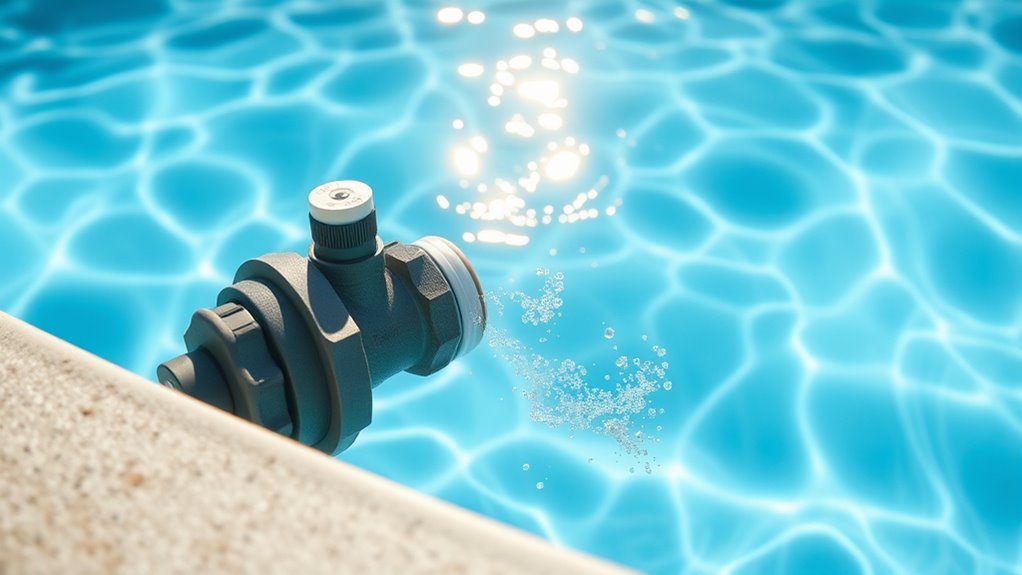
You’ll know it’s time to backwash when the water in your pool becomes cloudy or discolored. Additionally, if you notice your filter pressure gauge rising considerably, it’s a clear sign the filter needs cleaning. Paying attention to these signs helps keep your pool clean and your filtration system running smoothly. Regular maintenance also ensures optimal filter performance and prevents potential damage to your equipment.
Water Clarity Changes
Ever wonder how to tell when your pool needs backwashing? Water clarity is a quick clue. If your pool looks cloudy or has a dull appearance, it’s time to consider backwashing. Clear water with a slight sparkle indicates good filtration. But when murkiness or discoloration appears, particles are clogging the filter. Regularly checking water quality can help you catch these signs early and maintain optimal filtration efficiency. Here’s a simple way to visualize it:
| Water Clarity | Indicator for Backwashing |
|---|---|
| Crystal clear | No action needed |
| Slight cloudiness | Monitor closely |
| Murky or discolored | Time to backwash |
| Green or algae | Address chemical balance first |
Pay attention to these changes, and you’ll know when your filter needs a boost without draining the basin.
Increased Filter Pressure
Monitoring filter pressure is one of the most reliable ways to determine when backwashing is needed. When your pressure gauge shows a steady increase—typically 8 to 10 psi above normal operating pressure—it indicates your filter media is becoming clogged with debris. This buildup restricts water flow, reducing filtration efficiency. You might notice your pool’s water isn’t as clear or that circulation feels sluggish. Don’t wait until the pressure spikes considerably; early detection helps prevent damage to your system. Keep a record of your normal operating pressure, and check it regularly. When you see a consistent increase, it’s time to backwash. Addressing pressure buildup promptly ensures your pool stays clean and your equipment runs smoothly, saving you time and potential repairs. Regular filter maintenance also helps maintain optimal flow and prolongs the lifespan of your filtration system.
Preparing Your Pool for Backwashing
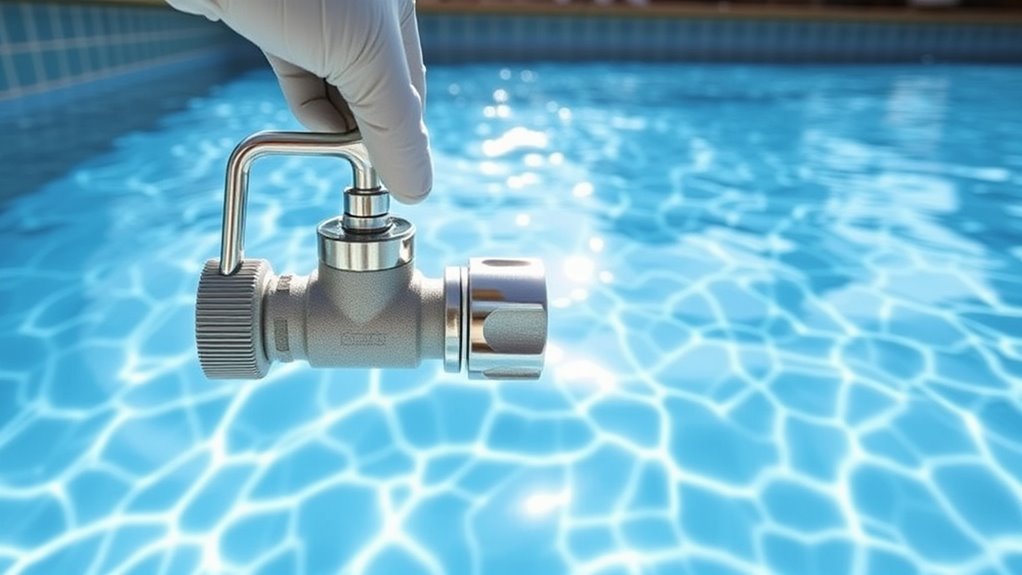
Before starting the backwashing process, it’s essential to prepare your pool properly to guarantee effective cleaning. First, turn off your pool’s pump and filter system. Clear the area around the pool to prevent debris from falling in during backwashing. Check the water level; it should be at least halfway up the skimmer opening to ensure proper circulation. Remove any debris from the skimmer basket and pump strainer to avoid clogging. Also, review your pool’s chemical levels and adjust if necessary, as clean water helps the filter work efficiently. Finally, gather your backwash hose or equipment, ensuring it’s ready for use. Proper preparation minimizes issues during backwashing and ensures your filter clears out dirt and debris effectively.
Setting Up Your Backwash Equipment Correctly
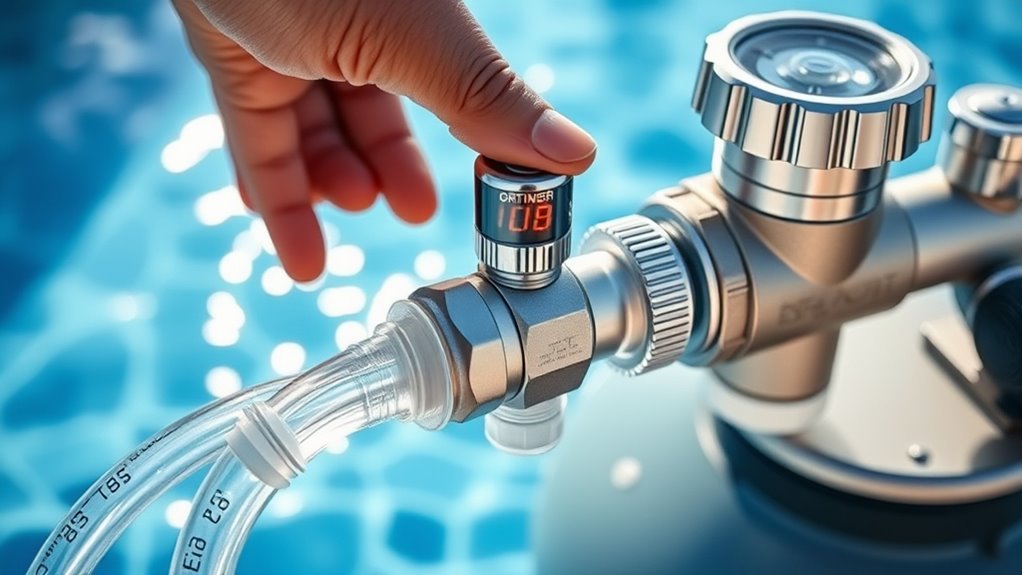
To guarantee your backwash process works efficiently, you need to set up your equipment correctly. First, ensure your filter’s valve is in the “Backwash” position. Second, connect your backwash hose securely to prevent leaks. Third, verify the drain outlet is clear and properly positioned to direct water away safely. Fourth, check that your pump is functioning correctly and has enough power to handle the backwash process. Make sure all connections are tight to avoid air leaks or water loss. Confirm that your valve settings are correct and that the hose is positioned to prevent water from spilling or causing damage. Proper setup minimizes mess and maximizes filtration efficiency, saving you time and effort during backwashing. Additionally, inspecting your filter components regularly can help ensure optimal performance and prevent unexpected issues.
Executing the Backwash Process Safely

Are you ready to start backwashing safely? First, verify the pump and valve are properly positioned according to your setup. Turn on the pump gradually to prevent sudden pressure surges. Keep an eye on pressure gauges and listen for unusual noises. If you notice leaks or abnormal sounds, stop immediately and inspect your connections. Never leave the equipment unattended during backwashing. Maintain a safe distance from moving parts and high-pressure outlets. Use protective gear like gloves and goggles if necessary. Once the process begins, monitor for consistent flow and pressure. When finished, turn off the pump carefully and double-check all valves are securely closed before proceeding. Following these safety steps helps prevent accidents and keeps your equipment in good shape. Additionally, understanding Vetted – Halloween Product Reviews can help you choose the right accessories to enhance your costume or safety gear.
Monitoring Water Clarity During Backwashing
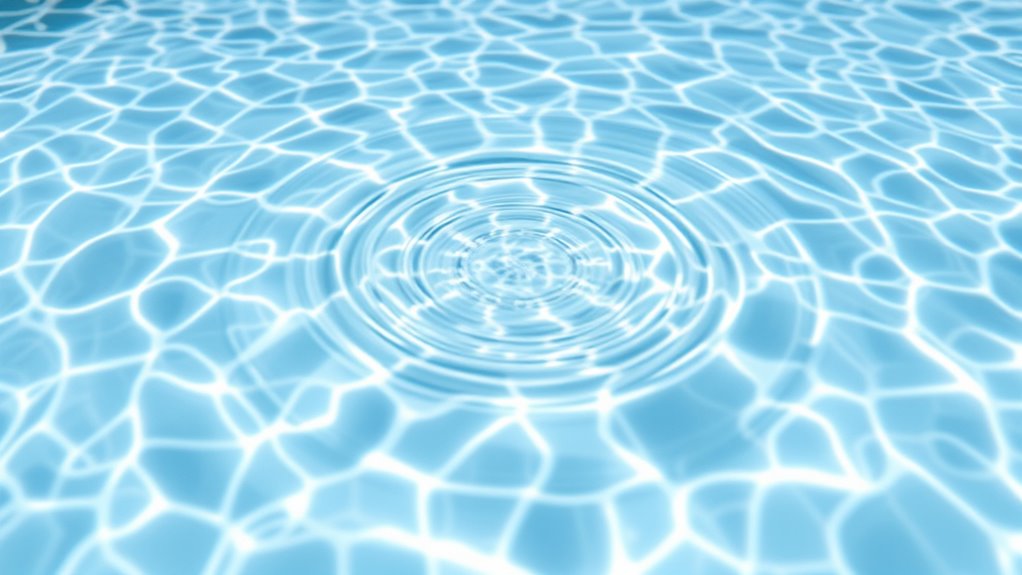
Monitoring water clarity during backwashing is essential to guarantee the filter media is being properly cleaned. You need to observe the water as it flows out of the backwash outlet. Clear water indicates the media is clean, while cloudy or muddy water shows residual debris. To effectively monitor, follow these steps:
Monitoring water clarity during backwashing ensures proper cleaning and optimal filter performance.
- Watch the discharge water closely during the backwash cycle.
- Note when the water begins to clear.
- Continue backwashing until the water runs almost clear.
- Stop the process once clarity is achieved to avoid over-washing.
- Remember that proper filter maintenance ensures optimal performance and longevity of your system.
Keeping an eye on water clarity ensures you’re not wasting time or water, and it confirms your filter is thoroughly cleaned. This simple check helps maintain ideal filtration performance without unnecessary draining.
Rinsing the Filter to Remove Residue
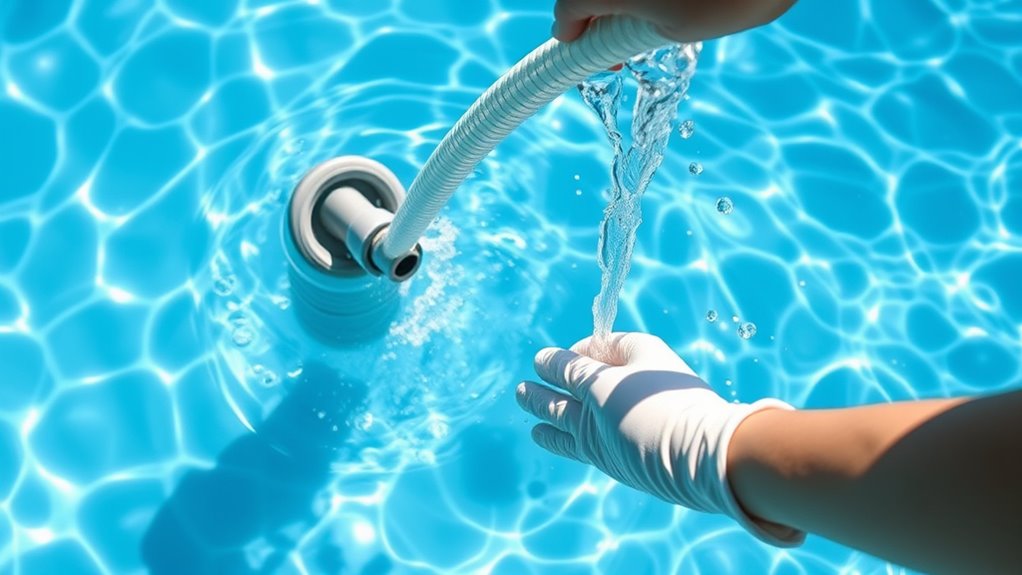
Have you ever wondered how to guarantee your filter is completely free of residue after backwashing? Rinsing the filter is a vital step. After completing the backwash cycle, turn the pump off, then switch the valve to the rinse position. Turn the pump back on for about 30 seconds to a minute. This process flushes out remaining debris and loose dirt from the filter media, ensuring no residue stays behind. Be sure to observe the flow: it should be clear and steady. If you notice cloudiness or debris, run the rinse longer. Once the water runs clean, turn off the pump and switch the valve back to the filter position. Rinsing effectively helps keep your pool water crystal clear and your filter functioning efficiently. Using a high-quality airless paint sprayer can also make surface preparation easier and more thorough before backwashing.
Restarting the Pool Circulation System

After rinsing the filter and making certain the water runs clear, it’s time to restart the pool circulation system. First, turn the pump back on, making sure all valves are in the correct position. Next, set the filter switch to the “filter” mode to resume normal operation. Then, check that the pressure gauge reads within the normal range, indicating proper flow. Finally, observe the water flow for a few minutes to confirm everything is running smoothly. If you notice any irregularities, turn off the pump and double-check valve positions or clear blockages. Restarting the system correctly helps maintain clean, healthy water and prevents future problems. Proper restart ensures your filtration system functions effectively after backwashing. Incorporating digital literacy into your maintenance routine can also help you monitor and troubleshoot system issues more effectively.
Tips for Maintaining a Healthy Pool Without Draining
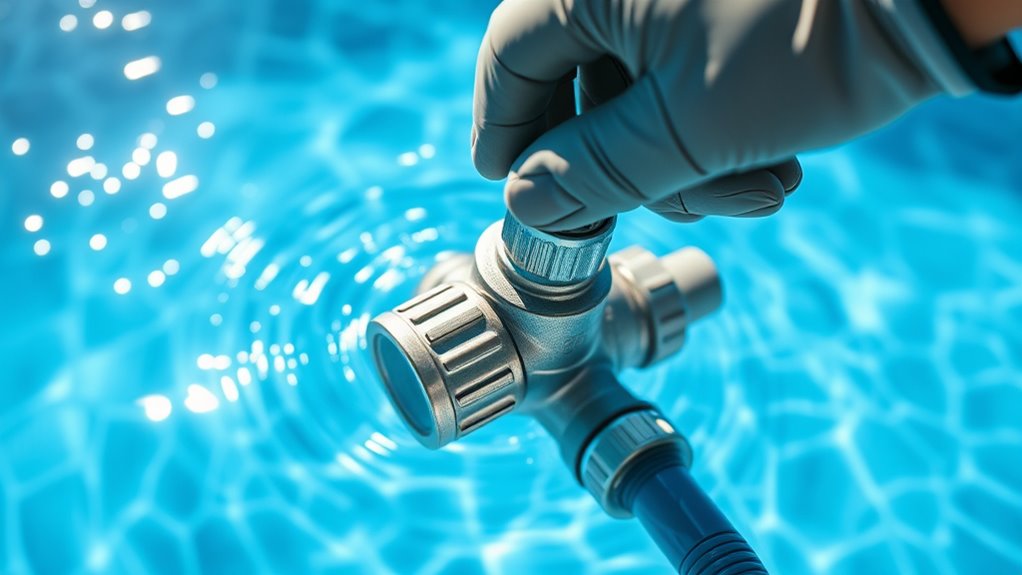
To keep your pool in top shape without draining, you need to regularly test the water to catch issues early. Proper filter backwashing helps remove debris without disrupting chemical balance, while maintaining balanced chemical levels prevents algae and bacteria growth. Staying on top of these tasks guarantees your pool stays clean and healthy all season long. Additionally, air purifier maintenance plays a role in ensuring your pool environment remains free of airborne contaminants that could affect water quality.
Regular Water Testing
Regular water testing is essential for maintaining a healthy pool without the need for draining. It helps you catch imbalances early, preventing issues before they become costly. To keep your water in top shape, focus on these four key tests:
- pH Level: Aim for 7.2–7.6 to keep water balanced and comfortable.
- Chlorine Levels: Maintain 1–3 ppm for effective sanitation.
- Alkalinity: Keep it between 80–120 ppm to stabilize pH.
- Calcium Hardness: Target 200–400 ppm to prevent scaling or corrosion.
Test your water weekly using reliable test kits or digital testers. Consistent testing allows you to adjust chemicals promptly, ensuring your pool stays clean and safe without draining.
Proper Filter Backwashing
Proper filter backwashing is essential for maintaining clear and healthy pool water without the need for draining. When your filter becomes clogged with dirt and debris, it loses efficiency, leading to cloudy water and potential damage. To backwash correctly, turn off the pump and set your filter to backwash mode. Run the pump until you see the water in the sight glass turn clear, usually about 2-3 minutes. Then, turn off the pump, set the filter to rinse, and run for about a minute to settle the media. Finally, return the filter to its normal operational setting and restart the pump. Regular backwashing keeps your filter functioning efficiently, prevents water quality issues, and extends the lifespan of your equipment.
Balanced Chemical Levels
Maintaining balanced chemical levels is essential for a healthy pool, and you can do it without draining water. Proper chemical balance keeps algae, bacteria, and cloudiness at bay. To achieve this, follow these tips:
- Regularly test your water with a reliable kit to monitor pH, alkalinity, and sanitizer levels.
- Adjust chemicals promptly—add chlorine or algaecide as needed to maintain proper sanitizer levels.
- Keep pH between 7.2 and 7.6 to prevent corrosion and scaling.
- Shock the pool weekly or after heavy use to clear contaminants and restore balance.
Staying consistent with testing and adjusting will help you avoid imbalances, reducing the need for water draining and ensuring your pool stays clear and inviting.
Frequently Asked Questions
Can I Backwash My Pool During Peak Usage Hours?
Yes, you can backwash your pool during peak hours, but it’s best to do it when fewer people are swimming. Backwashing temporarily disrupts filtration and water clarity, so doing it during busy times might cause inconvenience. If you need to backwash during peak hours, do it quickly and verify the pool is safe for swimmers afterward. Consider scheduling backwashing during less busy times for minimal disruption.
How Often Should I Backwash Without Draining the Basin?
Think of your pool like a heartbeat—regularly check its rhythm. You should backwash your filter when the pressure gauge rises 8-10 psi above the normal operating level, typically every 3-4 weeks. Don’t wait until the water looks cloudy or the pressure spikes. Regular backwashing keeps your pool clean and healthy, reducing the need for draining, and guarantees your swimming experience stays smooth and invigorating.
What Signs Indicate Backwashing Is Insufficient?
You’ll know backwashing is insufficient if your pool’s water remains cloudy or dirty despite the process. If you notice reduced water flow or pressure in your filter, it’s a sign it’s not cleaning effectively. Additionally, if the water level rises or debris isn’t being removed, your filter isn’t doing its job. Regularly check the clarity of your water and the pressure gauge to guarantee your backwashing is working properly.
Is It Possible to Backwash With a Sand Filter Manually?
You can manually backwash your sand filter, but it requires a bit of patience and know-how. First, turn off the pump and set the valve to backwash. Then, slowly open the valve to let water flow in reverse, flushing out debris. Keep an eye on the sight glass until clear, then switch valves to rinse. It’s a hands-on task, but with care, you’ll keep your filter running smoothly without draining the basin.
Are There Alternative Methods to Clean the Filter Without Backwashing?
Yes, you can clean your filter without backwashing by manually cleaning the sand or media. You should turn off the pump, remove the filter top, and use a hose or a filter cleaning tool to rinse the sand thoroughly. For sand filters, consider a deep cleaning with a specialized filter cleaner periodically. Regular maintenance like brushing the interior and removing debris also helps keep your filter functioning efficiently.
Conclusion
By mastering how to backwash without draining your pool, you save time and water—an essential benefit since over 75% of pool owners waste unnecessary resources. Regular maintenance keeps your water crystal-clear and saves you money in the long run. Remember, understanding your filtration system and staying attentive to water clarity will help you maintain a healthy, inviting pool year-round. With these tips, you’ll enjoy a clean pool without the hassle of draining.


